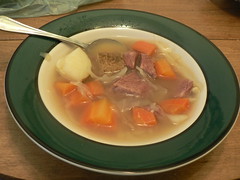When cooking meat, one can use two types of heat: dry or wet. Grilling, sautéing, broiling, roasting, deep frying, and stir frying all use dry heat. Pot roasting, stewing, braising, steaming, slow cooking, and poaching use wet heat. The type of heat is chosen depending upon the part of the cow that you are cooking. Since the center of the cow is not used for much activity, these steaks are very tender, so they are best cooked quickly in dry heat. However, areas used for movement tend to be stronger and thus are best cooked in wet heat for a long time.
When cooking meat, there is a two stage process. In the first stage, Maillard reactions form a crust on the cut of meat. In the second stage, the meat is cooked slowly throughout at a low temperature. Therefore, if you are grilling, divide you grill into two parts. One part place more briquettes than the other side to make it extra hot.
First place the steak on the hot portion of the grill to form the crust. Then move the steak to the other side of the grill to cook at lower temperature for a longer time. For a roast, you can cook it at a low heat for long time, and then finish by turning on the broiler to make the crust crisp. If you are cooking beef in a pan, make sure it is preheated to an appropriate temperature.
Cooking beef is a balancing act. You want to reduce moisture loss while cooking long enough that collagen melts into gelatin. While creating a crust is great for flavor, it does not keep the juices in the cut of meat. The only way to retain the juices is through slow coking at low temperatures.
Marinades have acid in them that help to denature the proteins in the meat. This makes the meats tender while adding flavor.
While marinades do not work miracles, they do help a tougher piece of meat becomes more edible.
After cooking the beef, it is important to let it stand. The water will squirt out of the meat if it’s cut immediately resulting in juices being lost. However, if you wait for five to ten minutes, the water will redistribute and less water is lost when cutting.
If you would like more information about cooking beef or beef recipes, visit http://www.cdkitchen.com today.

Tidak ada komentar:
Posting Komentar